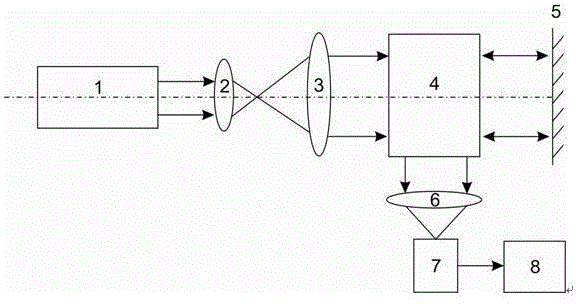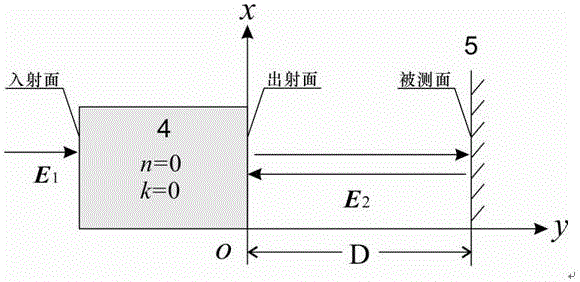Zero refractive index meta-material based precision optics ranging method
A zero-refractive index, precision optics technology, applied in optics, optical components, measuring devices, etc., can solve the problems of complex optical path construction and operation process, affecting popularization and application, and achieve simplified optical path design and operation steps, simple measurement methods, The effect of accurate phase change information
- Summary
- Abstract
- Description
- Claims
- Application Information
AI Technical Summary
Problems solved by technology
Method used
Image
Examples
Embodiment 1
[0045] When the incident light frequency of the light source 1 is TM polarized light with a frequency of 14.483 GHz, corresponding to a spatial wavelength of 2.07 cm, a two-dimensional square lattice structure photonic crystal is selected as the zero-refractive-index metamaterial 4 . Let the lattice constant of the photonic crystal be a, by Al 2 o 3 Dielectric pillars (dielectric constant ε=10) are periodically arranged in a square lattice structure in an air background (ε=1), and the radius of the dielectric pillars is 0.213a. When the period size of the photonic crystal array is 11.74mm, the radius of the ceramic pillars is r=2.5mm, forming a rectangular array of 15a×10a, the normalized frequency ω of the two-dimensional square lattice structure photonic crystal at the Dirac point D =0.567, corresponding to the effective refractive index n when the incident frequency is 14.483GHz eff =0.
[0046] according to figure 1 As shown, the optical ranging system is assembled. T...
Embodiment 2
[0048] The difference between this embodiment and Embodiment 1 is that a two-dimensional triangular lattice structure photonic crystal is selected as the zero-refractive-index metamaterial 4 . If the lattice constant of the photonic crystal is a, by Al 2 o 3 Dielectric pillars (dielectric constant ε=10) are periodically arranged in the air in a triangular lattice structure, and the radius of the dielectric pillars is 0.196a. When the photonic crystal array period size is 12.77mm, Al 2 o 3 The radius of the ceramic column r = 2.5mm, consisting of The rectangular array of this two-dimensional triangular lattice structure photonic crystal is normalized at the Dirac point frequency ω D =0.617, corresponding to the effective refractive index n when the incident frequency is 14.483GHz eff =0.
Embodiment 3
[0050] The difference between this embodiment and Embodiment 1 is that the incident light frequency of the light source 1 is TM polarized light of 16.2 GHz, which has a wavelength of 1.85 cm in vacuum, and a two-dimensional square lattice structure photonic crystal is selected as the zero-refractive index metamaterial 4. Alumina dielectric pillars (dielectric constant ε=12.5) are periodically arranged in the air in a square lattice structure, and the radius of the dielectric pillars is 2mm. When the period size of the photonic crystal array is 1cm, forming a rectangular array of 15a×10a, the normalized frequency ω of this two-dimensional square lattice structure photonic crystal at the Dirac point D =0.541, corresponding to the effective refractive index n when the incident frequency is 16.2GHz eff =0.
PUM
 Login to View More
Login to View More Abstract
Description
Claims
Application Information
 Login to View More
Login to View More - R&D
- Intellectual Property
- Life Sciences
- Materials
- Tech Scout
- Unparalleled Data Quality
- Higher Quality Content
- 60% Fewer Hallucinations
Browse by: Latest US Patents, China's latest patents, Technical Efficacy Thesaurus, Application Domain, Technology Topic, Popular Technical Reports.
© 2025 PatSnap. All rights reserved.Legal|Privacy policy|Modern Slavery Act Transparency Statement|Sitemap|About US| Contact US: help@patsnap.com



